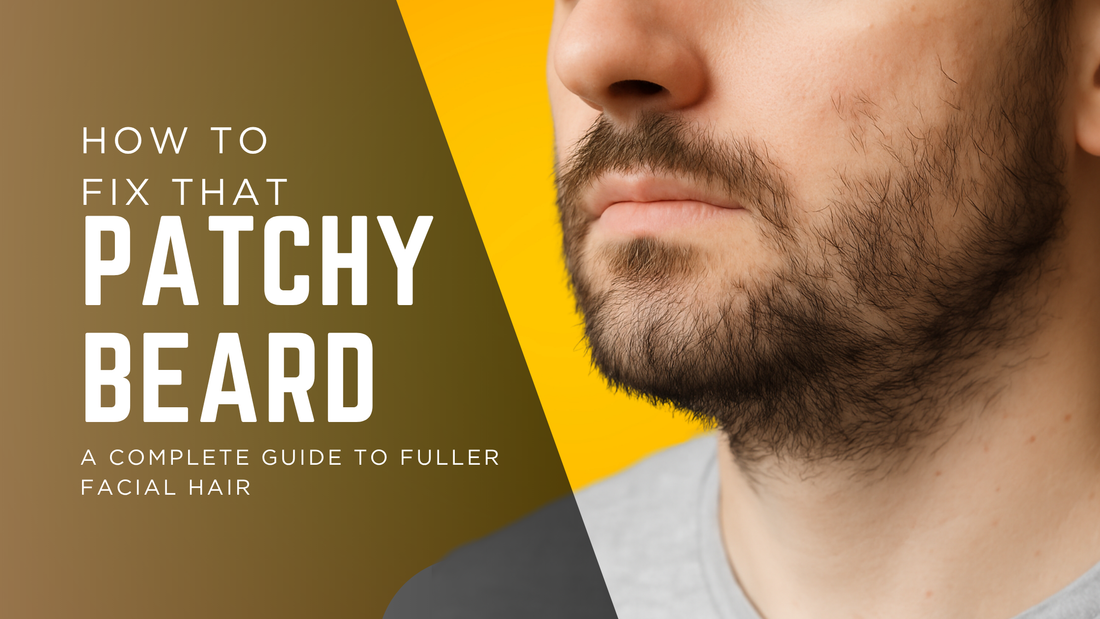
How to Fix Patchy Beard Growth: A Complete Guide to Fuller Facial Hair
Share
Nothing is more frustrating for the aspiring beardsman than staring in the mirror at a patchy, uneven beard that looks more like scattered whiskers than the full, masculine facial hair you’re dreaming of. If you’re dealing with patchy beard growth, you’re not alone—it’s one of the most common concerns among men trying to grow their first beard or improve their existing one.
The good news? Patchy beards aren’t a permanent sentence. With the right approach, patience, and techniques, most men can significantly improve their beard’s fullness and appearance. Let’s dive into the causes of patchy growth and examine proven strategies to help you achieve your desired beard.
Understanding Why Beards Grow Patchy
Before jumping into solutions, it’s essential to understand what causes patchy beard growth. The primary culprit is genetics—your DNA determines your hair follicle density and distribution pattern. Some men naturally have fewer follicles in certain areas, leading to gaps and thin spots.
Age also plays a crucial role. Many men don’t reach their full beard potential until their late twenties or early thirties. Hormones, particularly testosterone and dihydrotestosterone (DHT), influence hair growth patterns and can change over time. Additionally, lifestyle factors like stress, poor diet, and inadequate sleep can negatively impact hair growth throughout your body, including your face.
The Power of Patience: Give It Time
The most crucial advice for dealing with patchy beard growth might also be the hardest to follow: be patient. Many men give up on their beards too early, trimming or shaving at the first sign of patchiness. However, longer hair can often camouflage thin areas and create the appearance of fuller coverage.
Commit to growing your beard for at least 2-3 months without trimming the patchy areas. As your hair gets longer, it will begin to fill in gaps and create a more even appearance. This “awkward phase” is temporary, but pushing through it is essential for achieving your beard goals.

Strategic Styling and Trimming
Once you have some length to work with, strategic styling becomes your best friend. A skilled barber can work wonders with a patchy beard, using techniques like graduated trimming to blend thin areas with fuller sections. They might suggest keeping certain areas longer to cover patches while trimming others to create balance and symmetry.
Consider beard styles that work with your natural growth pattern rather than against it. If your cheeks are patchy but your chin and mustache grow well, a goatee or Van Dyke style might be perfect. If you have good coverage on your jawline but thin cheeks, a chin strap or extended goatee could be ideal.
Nutrition and Lifestyle Optimization
Your beard grows from the inside out, making proper nutrition crucial for healthy hair growth. Focus on getting adequate protein, as hair is primarily made of keratin—a protein structure. Include foods rich in vitamins A, C, D, and E, as well as B-complex vitamins, particularly biotin.
Zinc, iron, and omega-3 fatty acids also support healthy hair growth. Consider incorporating foods like eggs, nuts, fish, leafy greens, and lean meats into your diet. Some men find success with biotin supplements, though it’s best to consult with a healthcare provider before starting any supplement regimen.

Regular physical activity increases blood circulation, creating better nutrient delivery to the hair follicles in your beard area. Quality sleep is equally important, as your body repairs and regenerates during rest periods.
Topical Treatments and Products
Several topical treatments may help improve beard growth, though results vary among individuals. Minoxidil, the active ingredient in Rogaine, has gained popularity among men seeking to improve beard density. While not FDA-approved for facial hair use, some men report positive results when applied to patchy areas.
Beard oils containing growth-promoting ingredients like castor oil, jojoba oil, and essential oils may help create optimal conditions for hair growth while keeping your skin healthy. Regular massages during oil application can also improve blood circulation in the area.
Some men experiment with derma rolling or microneedling, which involves using a small roller with tiny needles to create micro-injuries that may stimulate hair growth. However, this approach requires careful research and potentially professional guidance.
Managing Expectations and Embracing Your Unique Growth
While these strategies can help many men improve their beard growth, it’s important to have realistic expectations. Genetics ultimately determine your hair growth potential, and not every man will achieve a perfectly full, thick beard. The goal should be to maximize your natural growth potential rather than completely transform your genetic blueprint.
Remember that many successful, attractive bearded men have started with patchy growth. The key is working with what you have, maintaining good grooming habits, and choosing styles that complement your natural growth pattern.

The Bottom Line
Fixing patchy beard growth requires a combination of patience, proper care, strategic styling, and realistic expectations. Focus on the factors you can control—nutrition, lifestyle, grooming habits, and styling choices—while accepting that genetics play a significant role in your beard’s ultimate potential.
Give your beard time to develop, experiment with different styles and products, and don’t be afraid to talk with with a professional barber who can help you make the most of your natural growth pattern. With persistence and the right approach, most men can achieve a beard they’re proud to wear.

